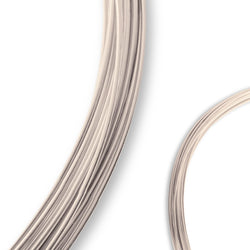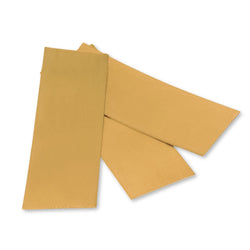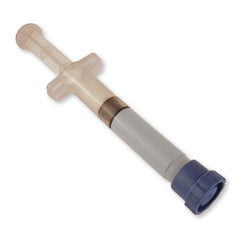Smycken Löd
Lyft upp dina smyckesskapelser med vårt professionella smyckeslod, skräddarsytt för att ge hållbarhet och briljans till dina mönster.
Välj från vårt mångsidiga sortiment, tillgängligt i tråd- , ark- och pastaformer , för att säkerställa starka bindningar och en felfri finish.
Oavsett om du är en erfaren juvelerare i Sydney eller en hantverksentusiast i Melbourne, hitta det perfekta lodet för dina projekt här.
Löd för varje smyckeprojekt
Vårt omfattande urval av lödmaterial möter behoven hos alla smyckesföretag. Trådlodet är idealiskt för exakt arbete och erbjuder kontroll och effektivitet. Lödplåt ger bred täckning för större ytor, vilket säkerställer enhetliga sammanfogningar. För enkel användning och exceptionellt flöde , är vårt lödlödning det bästa valet, perfekt för detaljerade uppgifter där precision är av största vikt.
Vi förstår vikten av kvalitet . Våra lod, tillgängliga i silver, guld och andra legeringar, är designade för att skapa sömlösa sammanfogningar , vilket ger dina pjäser den integritet de förtjänar.
Vanliga frågor
Solder is a metal alloy used in jewellery making to join two or more metal pieces together. It melts at a lower temperature than the metals being joined, creating a strong bond when it cools and solidifies.
Soldering is essential for various tasks like attaching jump rings, creating bezels, and repairing broken jewellery.
There are several types of solder used in jewellery making, including silver solder, gold solder, and platinum solder. These come in different forms such as hard, medium, and easy, each melting at different temperatures to accommodate various stages of the soldering process.
The difference between hard, medium, and easy solder lies in their melting points. Hard solder melts at the highest temperature, making it ideal for the initial stages of assembly. Medium solder has a mid-range melting point, while easy solder melts at the lowest temperature, perfect for final joins without disturbing previous solder work.
Solder melting temperatures vary depending on the type and hardness. For example, silver solder melts between 620°C to 770°C (1148°F to 1418°F), while gold solder melts between 710°C to 950°C (1310°F to 1742°F). It’s crucial to match the solder’s melting point to your project’s needs.
For beginners, easy solder is often the best choice due to its lower melting point, making it easier to work with. Silver solder in easy grade is commonly recommended for its versatility and ease of use, allowing beginners to practice without damaging their pieces.
Choosing the right solder depends on the metals you are working with, the type of join you need, and the stage of your project. Use hard solder for initial joins and easy solder for final joins. Match the solder’s metal type (silver, gold, etc.) to your base metal for compatibility and a seamless finish.
Att löda smycken hemma kräver en noggrann installation och rätt verktyg . Börja med en ren, brandsäker arbetsyta och samla dina nödvändiga lödningssaker: en ficklampa , lödning, flussmedel , betningslösning och säkerhetsutrustning. När du har placerat dina bitar som ska lödas, applicera flussmedel för att förhindra oxidation och möjliggöra ett jämnt lödflöde. Skär en liten bit lod och placera den nära sammanfogningen, värm båda delarna jämnt tills lodet rinner och sammanfogar de två delarna. Släck och bet sedan din bit för att rensa bort eventuella rester.
Att bestämma sig för om man ska använda tråd, ark eller limlod i din smycketillverkningsprocess beror på de specifika kraven för ditt projekt och din kunskap om lödteknik.
Trådlödning föredras ofta för dess enkla hantering och precision; den är utmärkt för att nå in i trånga utrymmen och skapa ömtåliga fogar. För intrikat arbete, som när du fäster fynd eller utför detaljerade metallarbeten, kan trådlödning vara det bästa valet. Australiska juvelerare väljer ofta trådlod för dess mångsidighet och kontroll.
Plåtlod ger en fördel när större ytor kräver jämn täckning eller när du behöver skära exakta mängder för konsekventa fogar. Lödplåt kan skäras till, vilket ger juvelerare möjligheten att använda exakt den mängd som behövs, vilket minimerar avfallet. Denna form är särskilt lämplig för uppgifter som kräver att flera delar ska sammanfogas samtidigt.
Paste solder , å andra sidan, levereras förflussad och är ett bekvämt alternativ för nybörjare eller för de som arbetar på komplexa bitar där det är svårt att placera tråd eller arklod. Pastan kan appliceras direkt på fogen och är lätt att använda i produktionsarbetet, vilket säkerställer en konsekvent applicering med minimal rengöring.
Varje typ har sin egen uppsättning fördelar, och det bästa valet beror ofta på personliga preferenser och detaljerna för smyckena du skapar. Våra smyckenstillbehör erbjuder en rad lödalternativ för att passa olika kompetensnivåer och projektbehov, vilket säkerställer att du kan hitta den perfekta matchningen för ditt arbete.
Tänk alltid på smälttemperaturen och flödesegenskaperna för lodet du väljer, för att säkerställa att det kompletterar dina smyckens metall- och designkompletteringar effektivt.
Flux is a chemical compound applied to metal surfaces before soldering to prevent oxidation and ensure the solder flows smoothly. It helps create clean, strong bonds by keeping the metal surfaces clean and free from contaminants during the soldering process.
Safety precautions for soldering jewellery include working in a well-ventilated area, wearing protective eyewear and gloves, and using a heat-resistant surface. It’s also important to keep flammable materials away from your workspace and to use a fume extractor if possible.
Essential equipment for soldering jewellery includes a soldering torch, soldering block, flux, solder (wire, sheet, or paste), tweezers, a pickling solution for cleaning, and protective gear such as safety glasses and gloves.
När du väljer lödmetall för smycken är valet vanligtvis baserat på vilken typ av metall du arbetar med. För guldsmycken skulle du använda ett guldlod, medan för silverbitar är ett silverlod mest lämpligt.
Det är också viktigt att överväga smälttemperaturen och flödesegenskaperna (lätt, medium eller hård) för att säkerställa att det kompletterar tillverkningsprocessen för ditt smycke.
Att löda smycken är säkert när korrekta säkerhetsprotokoll följs. Det innebär att arbeta med hög värme och potentiellt farliga material, så lämplig ventilation, värmebeständiga ytor, skyddsglasögon och handskar är avgörande.
Att vara utbildad i lödningsprocessen och förstå materialet du arbetar med är också avgörande.
After soldering, clean up your jewellery piece by quenching it a pickling solution to remove any oxidation and flux residue. Rinse thoroughly and polish the piece to restore its shine.
Solder wire, sheet, and paste differ in form and application. Solder wire is versatile and easy to control, solder sheet is great for precise cutting into custom shapes, and solder paste is ideal for small, detailed work where control is essential.
The best solder for silver jewellery is silver solder, available in hard, medium, and easy grades. Easy silver solder is commonly used for its lower melting point, making it ideal for most silver jewellery projects.
For gold jewellery, gold solder is the best option. It is available in different karats to match the purity of the gold you’re working with. Use 14k or 18k gold solder, depending on the gold content of your jewellery piece.
Technically Yes, silver solder can be used on gold, however it is unadvised as the bond will not be strong and it will leave a visible seam. It’s best to use gold solder for a seamless finish that matches the colour and purity of the gold.
The best solder for platinum jewellery is platinum solder, which has a high melting point to match platinum’s durability. It ensures a strong bond and a consistent finish with the platinum metal.
Gold solder is made of a combination of gold, silver, copper, and sometimes zinc, depending on the karat and colour. The alloy is designed to match the colour and melting point of the gold being worked with.
For repairing broken jewellery, use a solder that matches the metal of the piece. Medium silver or gold solder wire is ideal for repairs because of its balance of low melting point and strength, which minimises the risk of damaging the surrounding metal, and provides long term durability.
To prepare metal for soldering, clean the surfaces thoroughly with a file or sandpaper to remove any oxidation or dirt. Apply flux to the joint to prevent further oxidation and ensure a smooth flow of solder.
To prevent solder from flowing where you don’t want it, be careful and selective with your flux and use a small amount of solder to control the flow. Position the piece carefully so gravity works in your favour, and use heat strategically to direct the solder flow - Solder will flow in the direction where there is most heat!
Avoid melting your jewellery by using a flame that’s appropriate for the metal’s melting point and by applying heat gradually. Keep the torch moving to distribute the heat evenly and avoid focusing on one spot for too long.
The best way to solder jump rings is to first close the ring tightly, apply flux, and then heat the ring evenly with a torch. Apply a small amount of solder to the seam and let it flow to join the ends seamlessly.
To solder a chain, secure the links that need soldering on a heat-resistant surface, apply flux, and use a torch to heat the area. Apply a small piece of solder and allow it to flow into the joint, then cool and clean the chain. Use a small flame to avoid heat spreading to unwanted areas. Also consider using cross locking tweezers to isolate the soldering area and absorb excess heat from being distributed through other chain links.
To fix a broken solder joint, re-clean the area, apply flux, and reheat the joint with a torch. Add a small amount of solder to fill the gap and ensure a strong bond, then pickle and clean the piece.
Solder may not flow if the metal isn’t clean, the flux has burned off, or the piece isn’t hot enough. Ensure that the metal is clean, reapply flux if needed, and heat the entire joint evenly.
Solder balls up when the metal isn’t hot enough or when there’s a lack of flux. Make sure the metal reaches the correct temperature, and apply sufficient flux to help the solder flow smoothly.
To remove excess solder, file or sand the area carefully until it’s flush with the surrounding metal.
Improve your soldering skills by practising on scrap metal, learning to control the heat, and understanding the properties of different solders and metals. Experiment with different techniques, and always prepare your work area and materials thoroughly.
This specialised method involves pre-positioning small amounts of solder onto one of the pieces to be joined. Then, heat is applied to the opposite side of the metal, causing the heat to transfer through the piece and melt the solder, creating a secure bond.
Laser soldering uses a focused laser beam to heat and join small areas of metal with precision. It’s ideal for delicate work where traditional torches might cause damage, and it’s commonly used in high-end jewellery making.
Yes, you can solder at home with the right tools and safety precautions. Ensure you have a well-ventilated workspace, a soldering kit, and protective gear. Always follow safety guidelines to avoid accidents.
You can buy jewellery solder from various suppliers, including online retailers and specialised jewellery supply stores. However, Ore Metals stands out as the premier choice due to our superior quality and extensive range of options.
Store solder in a cool, dry place to prevent oxidation. Keep it in airtight containers or zip-lock bags with anti-tarnish strips to maintain its quality. Label different solders to avoid confusion.



